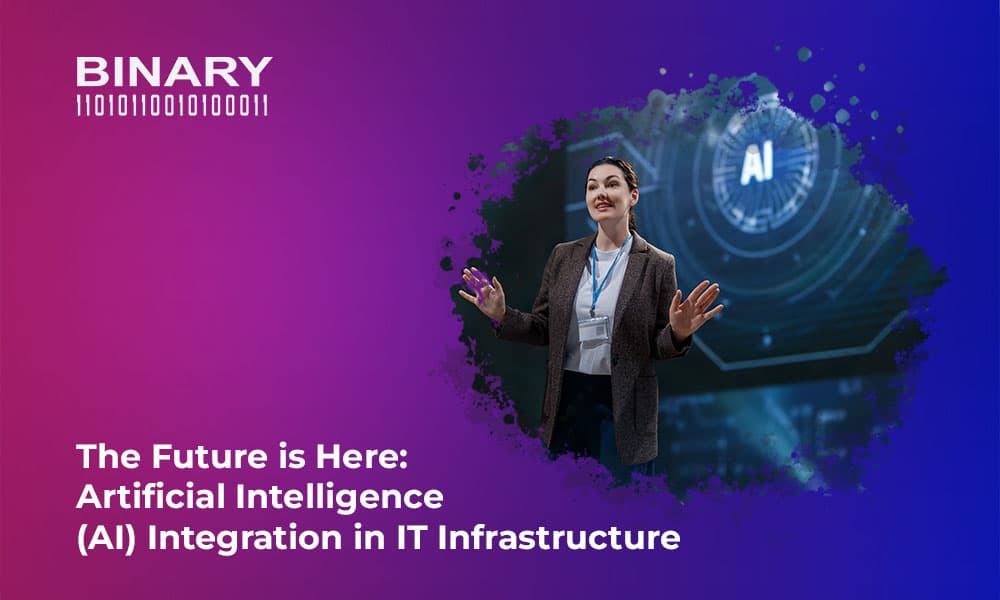The Future is Here: Artificial Intelligence (AI) Integration in IT Infrastructure

In the rapidly evolving world of technology, Artificial Intelligence (AI) has emerged as a transformative force, reshaping how IT infrastructure operates. Businesses across industries are harnessing AI to optimize processes, enhance decision-making, and deliver seamless experiences. In this blog, we’ll dive into the significance of AI integration, its benefits, real-world applications, and what the future holds.
Why AI Integration in IT Infrastructure is a Game-Changer
AI integration involves embedding intelligent systems within IT infrastructure to automate and enhance operations. Unlike traditional systems, AI-driven infrastructure can:
• Self-learn and adapt to changing environments.
• Predict and prevent potential system failures.
• Optimize resource usage, reducing costs and energy consumption.
With growing data volumes and complex IT ecosystems, AI’s role has become indispensable for businesses aiming to remain competitive.
Key Benefits of AI Integration
1. Automation of Repetitive Tasks
AI enables IT teams to automate mundane tasks like system updates, patch management, and network monitoring. This saves time and allows teams to focus on strategic initiatives.
2. Enhanced Security
AI-powered systems detect anomalies and cyber threats in real time. Tools like machine learning algorithms can identify patterns that indicate potential breaches, enabling proactive responses.
3. Improved Decision-Making
AI analyzes large datasets to provide actionable insights. IT managers can make data-driven decisions to optimize operations and improve service delivery.
4. Scalability and Flexibility
AI systems scale seamlessly with business growth, ensuring consistent performance without the need for manual intervention.
Real-World Applications of AI in IT Infrastructure
1. Network Management
AI optimizes network performance by dynamically adjusting configurations based on traffic patterns and user demands.
2. Data Center Automation
Intelligent algorithms monitor energy usage, optimize cooling systems, and manage workloads for maximum efficiency.
3. Predictive Maintenance
AI tools forecast hardware failures, allowing IT teams to replace or repair components before they cause downtime.
4. Virtual Assistants and Chatbots
AI-powered virtual assistants streamline IT support by resolving common issues, reducing response times, and enhancing user satisfaction.
Future Trends in AI Integration
1. Hyperautomation
The combination of AI, machine learning, and robotic process automation (RPA) will take automation to the next level, creating self-sustaining IT environments.
2. AI-Driven Cloud Operations
AI will play a pivotal role in managing cloud infrastructure, optimizing resource allocation, and ensuring high availability.
3. Quantum Computing Synergy
As quantum computing matures, AI will leverage its power to solve complex problems at unprecedented speeds.
How to Get Started with AI Integration
To stay ahead, businesses must prioritize AI integration in their IT strategy:
• Assess Current Infrastructure: Identify areas where AI can add value.
• Choose the Right Tools: Select AI platforms that align with business goals.
• Invest in Skill Development: Train teams to work with AI-driven tools and systems.
Conclusion
The integration of Artificial Intelligence in IT infrastructure is no longer optional; it’s a necessity for businesses aiming to thrive in the digital age. By automating processes, enhancing security, and improving decision-making, AI is paving the way for smarter, more efficient IT operations.
As AI technologies continue to evolve, organizations that embrace these advancements today will be better positioned to lead tomorrow.



